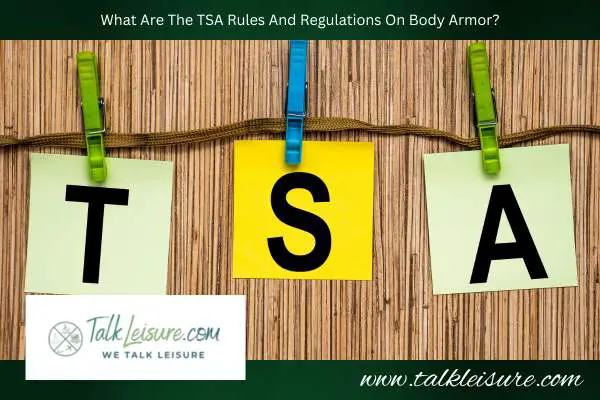In today’s world, personal safety is of utmost importance.
Many individuals choose to wear body armor as a form of protection.
However, when it comes to traveling, there can be some confusion about whether or not you can fly with body armor.
This blog post will dive into the facts and regulations surrounding this topic to clarify and help you make informed decisions.
So, buckle up as we explore the ins and outs of flying with body armor.
Before packing body armor for a flight, it is crucial to understand the rules and regulations regarding its transportation.
While the Transportation Security Administration (TSA) allows passengers to travel with body armor, there are some guidelines to follow.
Firstly, checking the legal restrictions on body armor in both your departure and destination countries is important.
While body armor is generally legal for civilian use, some countries may have specific regulations or restrictions.
Traveling with body armor on a plane is possible if you follow the necessary guidelines and regulations.
Ensuring compliance and proper handling will help you travel safely and securely.
What Is The Importance Of Body Armor?

Body armor is crucial protective equipment to protect the wearer from threats or harm.
Military personnel, law enforcement officers, security personnel, and individuals concerned about personal safety commonly use it.
The importance of body armor cannot be overstated, as it provides a layer of protection against ballistic projectiles, including bullets and shrapnel.
It can also offer protection against stab and slash attacks.
The primary purpose of body armor is to absorb and disperse the impact energy of projectiles or sharp objects, effectively reducing the risk of injury or fatality.
It is important to note that body armor comes in different levels of protection, ranging from soft armor plates capable of stopping handgun rounds to hard armor plates that can withstand rifle rounds.
Various types of body armor are available in the market, including bulletproof vests, tactical vests, plate carriers, and concealable armor.
The specific type of body armor a person chooses depends on their intended use, the level of protection required, and their comfort preferences.
The importance of body armor cannot be emphasized enough, as it can significantly enhance personal safety in dangerous situations.
It is essential to select the appropriate type and level of body armor based on individual needs and local regulations.
Can You Fly With Body Armor?

Flying with body armor is possible, but some important considerations must be remembered.
The Transportation Security Administration (TSA) allows body armor to be carried on both in checked luggage and carry-on bags.
However, it’s important to check the specific regulations and guidelines of the airline you’re flying with, as they may have additional restrictions or requirements.
Preparing for the flight with body armor involves being aware of your luggage’s weight and size limitations, as different airlines may have different restrictions.
Alternative options are available if you cannot bring body armor on the plane or ship it internationally.
While it is possible to fly with body armor, it’s crucial to familiarize yourself with the TSA rules and regulations and any specific guidelines provided by your airline.
By doing so, you can ensure a hassle-free travel experience while keeping yourself protected.
Are There Legal Restrictions On Body Armor In Different Countries?

When traveling with body armor, it is important to be aware of the legal restrictions that may exist in different countries.
These restrictions vary greatly, so researching and understanding the regulations before your trip is crucial.
Some key considerations regarding legal restrictions on body armor include:
1. Different countries may have different laws regarding the ownership and possession of body armor. While owning and using body armor in one country may be legal, it could be prohibited in another.
2. Some countries may require a license or permit to possess and transport body armor. This could involve obtaining special documentation or authorization from local authorities.
3. It is also important to consider the specific type of body armor you are traveling with. Some countries may have restrictions on certain types of armor, such as those designed for military or law enforcement use.
4. When planning your trip, check the laws and regulations of your departure and destination countries. This will help ensure compliance and avoid any legal issues while traveling.
5. It is advisable to contact the embassy or consulate of the country you plan to visit to inquire about their specific regulations on body armor.
Remember, the rules and regulations regarding body armor can change, so staying informed and updated with the latest information is essential to ensure a smooth and hassle-free journey.
What Are The TSA Rules And Regulations On Body Armor?

When flying with body armor, it’s important to understand the rules and regulations set by the Transportation Security Administration (TSA).
The TSA allows body armor to be carried on or checked-in luggage, but there are a few guidelines to follow.
First, body armor must be packed to allow TSA officers to inspect it easily.
This means that other items in your luggage should not obstruct it.
If you carry body armor in your carry-on bag, it should be placed in a bin separate from your other belongings during the screening process.
It’s worth noting that some types of body armor may contain materials that could set off the metal detectors.
Similarly, steel-toe boots may also set off metal detectors, although they are allowed on planes.
If this happens, the TSA may need to conduct additional screening procedures, such as a pat-down or handheld metal detectors.
If you’re unsure about the rules regarding body armor, it’s recommended to contact your airline or the TSA directly for specific guidelines.
Where To Pack The Body Armor (Carry-On Or Checked Luggage)?

When flying with body armor, it’s important to know where to pack it – whether in your carry-on or checked luggage.
The Transportation Security Administration (TSA) allows body armor to be transported as checked or carry-on luggage, but there are a few things to remember.
If you’re packing body armor in your carry-on, you should check with the airline beforehand, as they may have specific guidelines or restrictions.
Generally, it’s recommended to place the body armor in a separate bin during the security screening process to facilitate the inspection.
If you prefer to pack the body armor in your checked luggage, ensure that it’s properly secured and protected to prevent damage during transport.
It’s advisable to contact the airline or check their website for any specific regulations regarding packing body armor in checked luggage.
Remember, you must comply with all applicable regulations and guidelines to ensure a smooth and hassle-free travel experience with your body armor.
What Are The Tips For Preparing For The Flight With Body Armor?

When preparing for a flight with body armor, there are a few essential tips to keep in mind:
1. Before packing your body armor, check the airline’s policy regarding traveling with protective gear. Some airlines may have restrictions or additional requirements for carrying body armor.
For instance, airline policies of the destination country may have restrictions when flying with chocolates, cast, body armor, PICC line, etc.
2. Place your body armor in a sturdy travel bag or case to protect it during the journey. Consider using a bag with lockable compartments to ensure the safety and security of your gear.
3. When going through airport security, inform the officers that you carry body armor. This will help them understand what they are looking at on the X-ray scanner and prevent unnecessary delays or confusion.
4. Follow the guidelines set by the Transportation Security Administration (TSA) regarding the transportation of body armor. Ensure the armor is empty and has no prohibited items attached to it, such as knives or firearms.
5. Your body armor may need to undergo additional screening, such as a swab test for explosive residue. Stay calm and comply with any requests from security personnel for a smooth screening process.
What Are The Alternative Options For Shipping Body Armor?

When it comes to shipping body armor, there are alternative options available if you cannot bring it with you on a plane:
1. Contact shipping companies that specialize in transporting firearms and ammunition. They may have policies in place to ship body armor as well.
2. Check with retailers who sell body armor. They may offer shipping services or partner with shipping companies that can handle your transportation.
3. Reach out to body armor manufacturers directly. They can guide the best shipping options and offer shipping services.
4. If you are a military or law enforcement member, you can utilize the established channels provided by your organization to ship the body armor.
5. If you need to ship body armor internationally, research the laws and regulations of the destination country. Some countries may have restrictions or additional requirements for importing body armor.
It’s important to follow the proper procedures to ensure your body armor’s safe and legal transportation.
Conclusion
In conclusion, while it is generally allowed to fly with body armor, there are several considerations and regulations to keep in mind.
TSA rules and individual airline policies may vary, so checking with the specific airline beforehand is essential.
International regulations also differ, and it is essential to research and comply with the destination country’s rules.
When packing body armor for a flight, it is recommended to pack it in checked luggage and declare it at the check-in counter.
Going through security with body armor may require additional screening, and it is advisable to cooperate with security personnel.
In some cases, special permission or exceptions may need to be granted, especially in jurisdictions with stricter regulations.
Overall, following the guidelines and ensuring a smooth travel experience with body armor is crucial.
FAQs
Can You Ship Body Armor Internationally?
Yes, you can ship body armor internationally, but certain regulations and restrictions need to be followed.
Before shipping body armor to another country, it is important to research and comply with that country’s specific laws and regulations regarding importing and possessing body armor.
Some countries may have strict regulations in place, while others may have no restrictions at all.
Can You Soft Body Armor On A Plane?
You can bring soft body armor on a plane as part of your carry-on luggage.
However, it is important to check the specific regulations of the airline and the airport you are flying from and any relevant laws and regulations of your destination.





